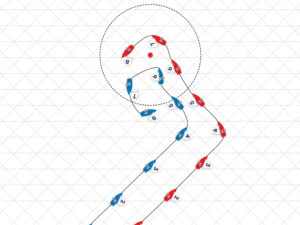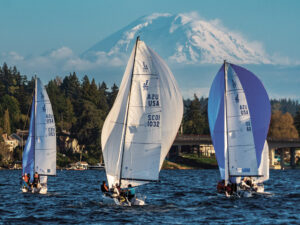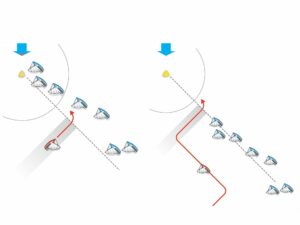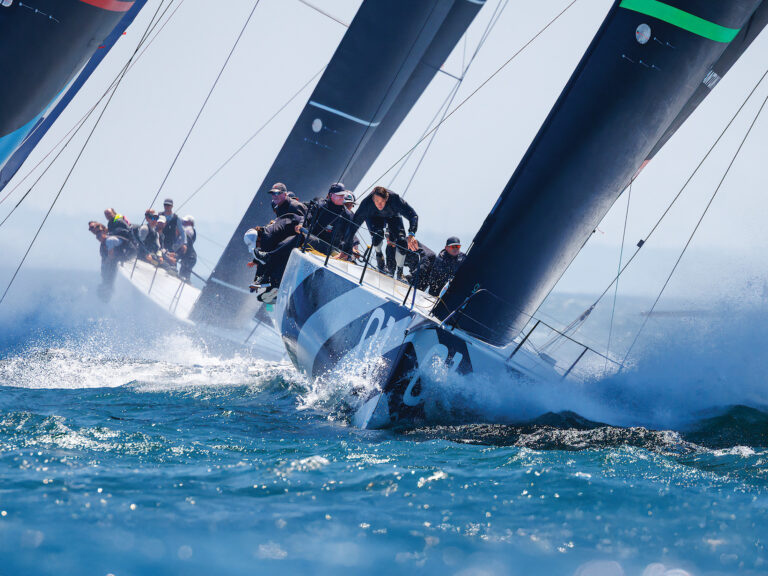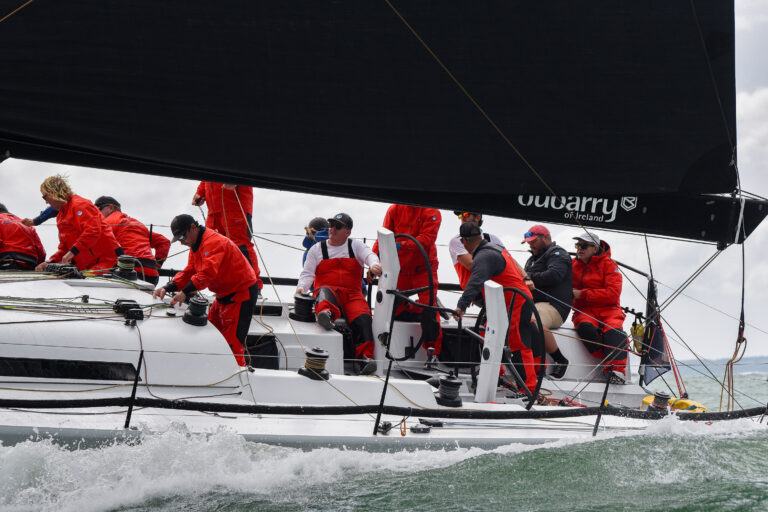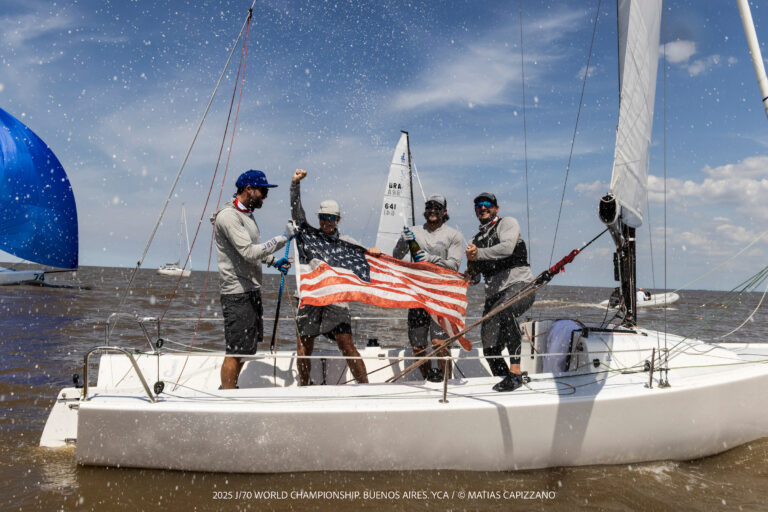
polar plot 368
Step aboard any well-sailed raceboat today and you’re guaranteed to find somewhere in the cockpit a laminated sheet of paper showing a spreadsheet full of letters and numbers. For everyone directly involved with the performance of the boat as it makes it way around a racecourse, this “Target Table,” a detailed matrix of optimum boat speeds and wind angles, is the all-essential cheat sheet. Every boat with instruments should have one because the information on these target sheets will guide you to your next mark, or destination, at the optimum speed. And that is what performance sailing is all about.
So how do we come up with these “targets” that get us around a racecourse as quickly as possible? Well, it all starts with polars. Let’s begin there, and later get to how to use your target tables.
Polars are boatspeed predictions across a range of wind angles and wind speeds. In its simplest form, a polar is a curved plot showing boatspeed versus course angle to the wind (true wind angle), for a fixed wind speed. This curved plot is called a polar because it is typically plotted using polar coordinates. Polar coordinates are simple: you have the origin (or center point of the plot), an angle radiating away from the plot axis, and a distance from the origin. Angle and distance, combined, determine a unique point on the plot.
|| |—| | Joseph Comeau| |**The polar plot(for a Cal 40) displays the optimum sailing angles (marked with an X) for a given true wind speed and direction. **| In the first diagram, straight lines radiate from the origin at 10-degree angles from the vertical axis, up to 180 degrees. Our polar plot assumes the true-wind is coming straight down from the top (see wind arrow on diagram) so all these 10-degree radiants are simply measuring the true wind angle. There are also half circles at fixed distances from the origin; these curves represent increasing intervals of boatspeed (in this case 0 to 10 knots). Our diagram actually shows a family of polars for a Cal 40. The yellow curves are our polars when sailing with a headsail; the orange polars are used when sailing with a spinnaker. The respective curves for sailing in 10 knots of wind are bolded.
What does this polar plot tell us? And how do we apply it to our race? With this visual it becomes very easy, and intuitive, to determine the best sailing angles, which will get us to the next mark in the least amount of time. Let’s say you’re racing to an upwind mark. Sailing upwind at any wind angle less than 90 degrees will get you there, but only one angle will be the fastest. If you pinch (sail too close to the wind), you’ll be pointing the boat closer to the mark, but your boatspeed will suffer as a result-the downward curve of the polar confirms this. It will take longer to get there. If you foot off too much, you’ll certainly gain boatspeed, but at the cost of not pointing close to where you want to go.
So the polar diagram shows us that too high is too slow and too low is too fast. How do we use the polars find that perfect angle? In the diagram above, we take a closer look at the upwind portion the polar chart. The solutions for optimal upwind sailing are marked with Xs. The polar chart makes it quite clear that this optimal point is where a horizontal line is tangent to the polar curve. This point is the point on the curve “furthest upwind,” and it is this speed upwind that we are trying to maximize. This upwind component is referred to as velocity made good (VMG), and sailing at that optimal angle gives the best VMG. [For all you vector heads, this is the vertical component of the velocity vector, drawn as an arrow from the origin to a point on the polar curve, as we’ve done in the diagram.
When sailing to a leeward mark you do the same thing, using the bottom portion of the polar curve. The interesting thing about offwind polars is they are generally much flatter in the region of maximum VMG; if you deviate slightly from your optimum angle, you actually lose very little of your VMG. In other words, there is very little penalty for sailing slightly high or low. This flatness in the curve, however, can also make it difficult to judge your optimum offwind angles. Judging these angles is especially difficult with lighter boats carrying lots of sail area, for which angles can change dramatically with windspeed. Heading up a few degrees from optimum increases apparent wind speed, increases the sail plan’s driving force, and increases boatspeed, which further increases the apparent wind, and the boat accelerates to a new equilibrium. High-powered, lightweight boats may easily speed up sufficiently to have a larger downwind VMG. This is why an accurate set of polars is so valuable in maximizing your offwind performance.
||
|—|
| ** **|
|****|
How to build and use your target tables
The most valuable use of a polar plot is also the simplest, and is one available to nearly any boat, even boats that have simple instrument systems. This is the use of the polar files to generate a table of target angles and speeds to sail when you’re trying to maximize your VMG, upwind or downwind. Extrapolating the data from the polar chart, I plug it into a basic table, print the table on paper, laminate it, put self-stick Velcro on the back, and post it where the helmsperson, main trimmer, and headsail trimmers can all see it.
Using the target table upwind
Before you read the table, get your true wind speed by either reading TWS from your instruments-if your instruments calculate it-or estimate the windspeed from the sea state. Most sailors can guess TWS within a knot. Once you know TWS, look up the “opt BS UW,” and then keep that number in mind as you race upwind. Do not use target speeds as gospel, however. Instead, use them as a reference and keep a constant dialogue going amongst your speed team (helm and trimmers). On a well-sailed boat you will hear such chatter as:
Helm: “On port tack, here, we’re slapping into a bit of a chop so the targets are too tough. Let’s live with two-tenths low.”
Helm: “We’ve got a well-mixed wind here and flat water, and I’m hitting targets too easily, let’s use 0.1 fast as our number.”
Trimmer: “We’ve got lots of right twisted wind aloft. Let’s use targets that are one-tenth slow and watch out for an increase in wind and a veer if the twisted wind drops down to the water.”
Even the grand-prix boats use their theoretical targets only as a reference, and on any given day use target numbers that are adjusted above or below the reference table. But once the crew picks the target for the current conditions, they pay tons of attention to it. You’ll hear lots of chatter like:
Trimmer (coming out of a tack): “We need a half a knot more here . . . need two-tenths more, OK we’re up to speed.”It’s best to not change the target table without a discussion with the trimmers and afterguard. Even if one column is off, and you’re always one-tenth low, even in perfect conditions, the crew gets familiar with the table so you should not change it without general agreement and awareness. On the Volvo Ocean Race, we set our target tables two weeks after first sailing ABN AMRO One and never changed them. They were not perfect, but everybody knew how to sail relative to them.
||
|—|
| ****|
|****|
Using your downwind targets
Start by reading the TWS from your instruments, or estimate it. Using the TWS, look up the optimum apparent wind angle (AWA). The same caveats apply as with upwind targets: you will sometimes use a number that is higher or lower of the target from the table, based on how the boat feels, the sea state, and whether there’s lots of wind sheer or whether the wind is well mixed, vertically.
Whether it’s better to use target true wind angle or target apparent wind angles when sailing downwind is a religious argument for which there is no right answer. As you can tell, I list both true wind angles and apparent wind angles on the target table and typically set up the instrument systems to display both so the helmsperson can use his or her preference.
Here’s the basic argument: On a fast boat, as the boat surfs and the boatspeed changes, the measured AWA will change dramatically. You don’t want the helmsperson chasing these AWA changes, so some feel that people steer better to a TWA target on fast boats. However, if you use TWA as a target, you also need to watch your target boatspeed (BS) to prevent an inattentive helmsperson from sailing along at the target TWA, but too slowly and with the AWA far too deep. This can be a stable state and the boat can stay at target TWA, but continuously sailing far too slowly, and never accelerating to the downwind target speed. So, when steering to target TWA, the helmsperson needs to watch the target BS and be sure to sail hot of target TWA until the boatspeed reaches the target BS, and then bear off to target TWA.
The benefit of steering a target AWA is that some things work naturally. For example, if the boat is sailing too slowly you will naturally come up to get the AWA to the target angle, and then as the boat speeds up and the AWA comes forward, you will naturally bear off to keep the AWA at the targets. But, again, as the boat accelerates and decelerates on waves, the helmsperson needs to be sure to not chase the AWA.
Different helmsmen use different approaches depending on their experience and on the conditions. Helmsmen with strong dinghy sailing backgrounds generally prefer AWA targets and are skilled enough sailors to naturally not chase the AWA as the boat surfs. When conditions are very windy (and likely dicey) downwind, many experienced sailors also like sailing to AWA because AWA (or measured wind angle MWA) is a raw value on instrument systems that responds quickly and is not subject to the vagaries of getting weed in the paddlewheel or the paddlewheel coming out of the water on surfs.
For more on using Polars in Offshore Races see “Take Your Polars Offshore”

